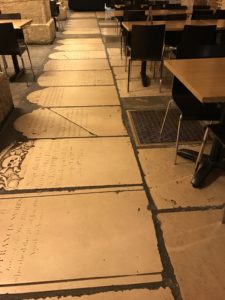Hello from London! Today we started with a hearty British breakfast at St.-Martins-In-the-Crypt: this is the cafe below St.-Martin-In-the-Field Anglican Church.

There has been a church on the site since medieval times, and the church was rebuilt in the 1540’s by Henry VIII. The site was literally “in the fields” between Whitehall and Westminster and prevented victims of the plague, which was common in summers in London, from coming through the area of the King’s Palace at Whitehall. The current structure is in the neoclassical style and was completed in the 1700s. The catacombs were cleared between 1939 and 1941, allowing the area to be used as a bomb shelter in World War II. The crypt has since become a cafe area and also houses a gallery.

Following breakfast, we crossed Trafalger Square and headed to Westminster Abbey and the many famous and infamous who are laid to rest there.

Sadly, photos are not allowed in the interior of the Abbey, so this post will have fewer pictures. There has been a church on this site for more than 1,000 years, but the exact date the first church began is not recorded. As we walked through the Abbey, in all areas including utilitarian areas like hallways, pieces of various kinds of stone in every size and color designated someone’s final resting place. In many cases, the letters can no longer be made out. The medieval era tombs that survive are few and are royal crypts that were above ground. At least some were moved during various stages of reconstruction in that part of the church. Of the stones we could read, the earliest were mid-1600s, indicating anything earlier was likely worn away or moved with construction/renovation projects of the period. The wealthy had heraldic shields, busts, or monuments constructed to their family members, and these don’t face the wear and tear of thousands of feet.

Of course, the Abbey is famous for Poet’s Corner, and as the final resting place for many Prime Ministers, Monarchs and heroes of the realm. There are always, of course, more interesting things to learn. Mary I, the Roman Catholic half-sister of protestant Elizabeth I, is interred in Westminster, which is unsurprising. What is surprising, however, is that Elizabeth’s grave lies on the coffin of Mary, and Mary has no monument. At the base of Elizabeth’s tomb is a Latin inscription that translates: “Partners both in throne and grave, here rest we two sisters, Elizabeth and Mary, in the hope of the Resurrection.” Also, Mary Stuart, Queen of Scots, who was Elizabeth’s cousin, is entombed here. Elizabeth held her prisoner for 19 years before finally ordering her death based on proof that Mary was involved in a plot on Elizabeth’s life. She had Mary entombed at Peterborough Cathedral in a Protestant service. But it was Mary’s son, James, who became King of England when Elizabeth died. He ordered a tomb built for his mother in Westminster, precisely opposite of Elizabeth (they are on either side of the Lady Chapel). The Abbey held so many stories and beautiful tributes and monuments, it would take years to learn them all.
After leaving the Abbey, we visited the Churchill War Rooms, one of five branches of the Imperial War Museum (again, photos were discouraged). This underground warren of rooms was command central during World War II, and Churchill broadcast his BBC speeches from here during the war. The area was shuttered after VE Day, and left surprisingly untouched until it was converted to a museum in the 1980s. The focus is more on Churchill himself and his career and leadership rather than on Britain’s role in the war. The exhibit is interactive and provides insight into his childhood and the support of his wife, Clementine, throughout the war as well as the activities of his War Cabinet. There are also interesting examples of the propaganda issued by Japan and Germany in an attempt to discredit Churchill in key areas like India and France. For World War II buffs, the exhibit is excellent and worth seeing.

We are so sorry there are fewer pictures on this post – particularly of Westminster as the stained glass windows and many of the monuments are stunning. We encourage Googling them for a better idea of their grandeur, and hopefully, tomorrow’s adventures will allow photographs! Until next time – J & K